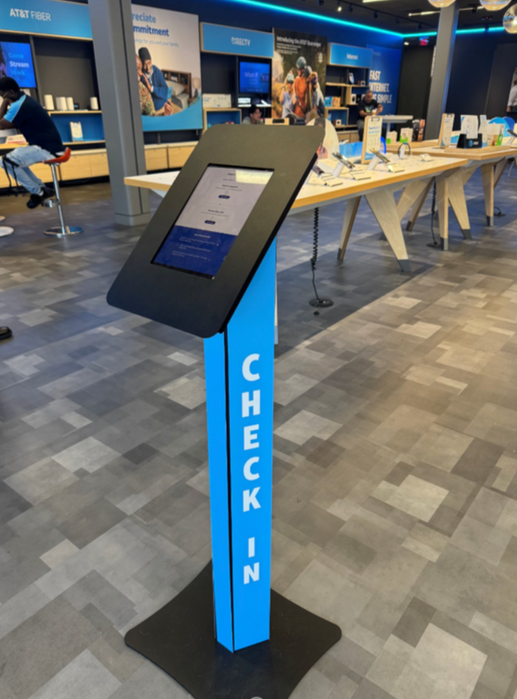


I led UX strategy to architect a brand-new intake system for retail stores from scratch. Through piloting and iterative testing, we delivered a scalable, omnichannel-ready solution that improved speed, order, and experience — laying the foundation for integrated queueing and BOPIS workflows.
Digital Check In
2023-2024
Designing a New Intake Experience from the Ground Up
When we walked into the stores, the check-in process was pure chaos.
There was no system. Some stores used paper sign-in sheets. Others relied on reps shouting across the floor or writing down names on sticky notes. It was inconsistent, slow, and — most of all — frustrating for both customers and employees.
That’s where we came in.
The Challenge
AT&T was preparing to launch a new in-store service offering that required structured check-ins. The existing methods weren’t scalable — or frankly, professional. We needed to design an intake system that brought clarity, order, and flow.
But we weren’t just designing a kiosk. We were designing a new behavior.
Discovery
There was no existing baseline to work from. No prior system to improve. This was a net-new platform. That meant we had to build not only the UI, but the surrounding ecosystem:
How do reps see who’s next in line?
How are visit reasons prioritized?
How does the kiosk talk to the rep’s tablet?
What happens if someone walks away mid-check-in?
We developed three prototype flows and piloted them across three different stores. We observed and iterated in real time.
Insights
Customers struggled with basic navigation and terminology.
Touch response was too slow for busy retail environments.
Fonts were too small; screen glare created accessibility issues.
Reps only saw customer names — not visit reasons — making triage nearly impossible.
In short, the system “worked,” but it didn’t fit the rhythm of the space. So we made it better.
Strategy
We revised the kiosk design for clarity, speed, and accessibility.
We also initiated conversations to extend the system — introducing QR check-in and online scheduling, laying the groundwork for true omnichannel service.
More importantly, we didn’t treat this like a stand-alone kiosk. We treated it like the first touchpoint in a connected retail experience. And that changed the stakes.
Outcome
Improved Interface: Faster load times, better UX, clearer navigation.
Scalable System: New logic now informs queue prioritization and omnichannel efforts.
Strategic Impact: Set the tone for future cross-platform integrations like BOPIS and mobile queueing.
Reflections
This project was a masterclass in systems thinking.
The kiosk wasn’t the solution — it was the entry point. What really mattered was designing the ecosystem around it: workflows, data sharing, human touchpoints.
Fixing the first mile unlocked opportunities all the way down the line.
MORE INFORMATION
EXPRNCE | RSCH | STRTGY | DSGN



